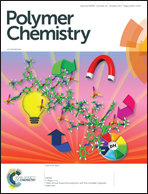Polyamino acid-based gemcitabine nanocarriers for targeted intracellular drug delivery†
Abstract
In the present study, we have successfully fabricated a biocompatible polyamino acid-based nanocarrier with reduction-sensitivity and targeting ability for gemcitabine (GEM) delivery. GEM-conjugated polyamino acid biotin-poly(ethylene glycol)-block-poly[(L-lysine-co-L-leucine)-graft-(GEM-co-rhodamine B)] (Biotin-PEG-b-P[(Lys-co-Leu)-graft-(GEM-co-Rho B)]) was synthesized by ring-opening copolymerization of L-lysine-N-carboxyanhydride (Lys-NCA) and L-leucine-N-carboxyanhydride (Leu-NCA) using biotin-poly(ethylene glycol)-amine (Biotin-PEG-NH2) as an initiator, and then disulfide linked GEM derivatives (HSEA-GEM) and Rhodamine B isothiocyanate (Rho B) were grafted onto polyamino acids. The obtained GEM-conjugated polyamino acids could self-assemble into nano-sized micelles in aqueous solution with a uniform spherical shape. The GEM nanocarriers showed reduction-sensitive drug release. Cell culture demonstrated that the polyamino acid itself showed excellent biocompatibility but high cytotoxicity when conjugated with GEM. What's more, the biotin-conjugated polyamino acid-based micelles could induce a remarkably higher internalization via receptor mediated endocytosis than non-biotin micelles. Hence, such biocompatible GEM-conjugated polyamino acids might provide a potential strategy for cancer therapy.



 Please wait while we load your content...
Please wait while we load your content...